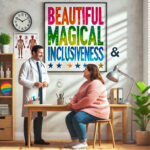Ed says U said – Eating Disorder Translator
Understanding the voice of anorexia has felt at times like I am talking a different version of English with my daughter – when I try to provide positive feedback, it is read as failure for her or that she is fat. When she says a particular food is awful, I am constantly challenged trying to decide if she is giving clues as to what she actually wants me to make her eat.
~ Mother
Anorexia is more than being thin – that’s really the smaller part. When my sister got sick that wasn’t what worried me, it was how different she was, and how she was changing mentally – the way the illness overshadowed her mind was really odd. Although I worried when she was skinny, I thought that was repairable, but mentally I sometimes thought: “Will she ever get back to true herself?”
~ Brother, a college student
About the book
Ed says U said unravels the complexities of eating disorders (referred to as ‘ED’) into layman’s language that you can understand. Using avatars and the Twitter-like title and format, this book pitches to a social media-conscious-audience. ‘ED’ is portrayed as an invisible bully that develops in the mind. Its agenda is to befriend, isolate and destroy by manipulating and sabotaging thoughts and behaviours. The biologically based mental illness feeds on misinterpretation. The mind-takeover is so complete that the sufferer often doesn’t understand they are ill and family, friends, colleagues and health professionals have no idea how to respond.
Why we wrote this book in a social messaging format
An eating disorder is a biologically based mental illness that can also cause serious physical health problems. Ed says U said seeks to explain the impact of the illness on thoughts, behaviours and relationships. The eating disorder, commonly referred to as ‘Ed’, is masterful at entangling not only the person who develops the illness, but also family members and friends, work colleagues and teachers, and even health professionals who are providing treatment, in its web. By understanding Ed’s language, you are in prime position to encourage and facilitate recovery. Learning how to avoid the pitfalls and defuse the triggers – the words, thoughts and actions that ‘feed’ the eating disorder – can assist greatly in counteracting effects and fallout.
In any language, one word can have several connotations and it’s the same with Ed. One word can defuse an eating disorder trigger or set it off. Unrestrained, the illness can turn a home into a minefield, with families tiptoeing around, afraid of what may come next, and beholden to Ed. Sometimes no matter what you say, the person with the eating disorder seems to take it the wrong way and pandemonium erupts.
An eating disorder, like other illnesses, has symptoms and consequences. A person sneezes and coughs because their body has a cold; a person says rude things, binges and starves because their body has an eating disorder. Heal the body, no more sneezes; heal the body, no more out-of-character behaviours, no more bingeing or starving. But an eating disorder does not make recovery easy: it affects physical, emotional and mental health, and while we all know when we have a drippy nose and cough, people with eating disorders can have great difficulty understanding the severity of their problem – in fact they may not believe they are ill at all, and be unable or helpless to acknowledge its effect on themselves or others. Even when insight is possible, and the sufferer is aware and wants to recover, the powerful hold of the eating disorder can sabotage the bravest of recovery efforts. Sufferers may function normally at some levels, but the eating disorder is a master of manipulation and misinterpretation, affecting both physical and psychological self.
Ed says U said provides a sneak peek into the deep, dark and often confusing world created by an eating disorder. We guide you through the layers of thought manipulation that occur as the eating disorder develops, peaks and wanes. Each conversation in this book is a real-life example where an eating disorder has influenced the dialogue. The dialogue often completely bewilders the family member, carer, friend or healthcare provider. People with experience of living with eating disorders also share internal dialogues to illustrate how decisions that seem spontaneous and impulsive for them can be anything but.
Ed says U said is here to help you understand how the illness influences, controls and distorts what a sufferer hears, thinks, says and does. Get ready for a chaotic ride as we take you inside the mind of people with an eating disorder (italics indicate the intrusive eating disorder thoughts).
You may think the language sounds like a new, not-so-nice version of Alice’s Adventures in Wonderland; that this language is fantasy. No, the voice of eating disorders is real for those who live with it. And the good news is: full recovery is possible. Hold on to this knowledge like a lantern of hope as you read through the darker passages of this book. A sense of humour and an ability to look at ‘the cup half full’ will be handy. Anorexia does not earn the title of having the highest death toll from any psychiatric illness lightly and, as with other eating disorders, recovery can be long and torrid. Patience is essential.
Genetics and biology play a big role in determining vulnerability for developing an eating disorder. We cannot change our genes or biology but we can learn skills and find support in our environment, to beat this illness at its game. The rewards are many. Ed says U said: Eating Disorder Translator will help you find the way.
In Ed says U said we draw on our combined experience of living with eating disorders for more than 60 years. We also draw on the expert, heartfelt and candid contributions of people like us around the world who know eating disorders well: people who have lived with Ed 24/7. Researchers, medical practitioners, dieticians, psychologists and therapists can provide vital information, help and support; but voices from experience give valuable extra insight.
Part One sets the scene, describing who will be on stage delivering the dialogues in this book – the sufferer, carer, family members, friends, clinicians, therapists, teachers – and the invisible bad guy, ‘Ed’.
Part Two opens with explanations of what a person living with Ed is thinking, and why, as the illness sets in. Early intervention is important for the best chance of full recovery, and you can’t start too soon in building a firm foundation of knowledge on which to formulate a recovery plan.
Experienced carers – mums, dads, siblings, children, grandparents and friends – all of whom have experience of living with Ed, offer advice in Part Three to help you navigate the often bewildering stage of eating disorder treatment.
In Part Four our survivors share their wisdom. Survivors have lived with, fought with, and banished Ed. Drawing on the clarity that recovery provides, they speak from experience on the reality of the ups, downs and everything in between that this journey entails.
Persevere; for the chapters in Part Five give a glimpse through the looking glass into the hopeful future that reaching full recovery can have in store. Stories shared by eating disorder survivors show that life can be regained and dreams fulfilled. The survivors’ words are a testimony of hope and encouragement to people who, through no fault or choice of their own, find themselves on an ED journey. Regaining a sense of self is possible. Regaining life, free of the eating disorder, is possible. Happiness, contentment, peace and connectedness can replace sadness, loneliness, alienation and isolation.
Part Six is like a cupboard stocked full of helpful resources and guidance for when an eating disorder enters your life, or the life of your loved one. Research indicates that while eating disorders affect people of all ages, they almost always start to develop or emerge in childhood or adolescence. So, from this young age, we need to be on the lookout. Prompt intervention provides best hope of a full recovery and, if you feel even a teeny bit concerned, check it out. Now.
Go to Part Seven to sort the facts from the fallacies about eating disorders. Misconceptions and unfounded beliefs abound and, unfortunately, they ‘feed’ the illness; make it worse. Myths are dangerous and deserve to be buried – without a headstone. Read this chapter so you can add your beat to the drum of truth and help to save lives.
Above all we hope that Ed says U said achieves our goal of helping you understand the language and voice of eating disorders.
Our story tellers
The stories you are about to read are real. They come first hand from sufferers, survivors, carers and loved ones. The stories are retold in conversation style like that found on social media – quick and direct. As with social media, our conversations have avatars – small, illustrated depictions of the speaker in each case. For clarity and simplicity, similar avatars represent people who hold similar roles – such as the various healthcare providers – and each person’s role is specified with a ‘handle’. A handle is a social media name which starts with the @ symbol, for example
@therapist.
Conversation contributors align on the left side of the page, except for the sufferer and/or Ed voice – which are aligned on the right. In this way it is very easy to tell, at a glance, who is talking at any point in the conversation. Here are a couple of the avatars you will meet in Ed says U said:
@mum I don’t get it! I only said it was nice to see her eat her dinner for once…
@dad Well it IS silly! Why doesn’t she just EAT?

About the authors
June Alexander and Cate Sangster provide the inside story in Ed says U said. The two Australian authors share their eating disorder experiences, plus those of other survivors, and also carers. The avatars and easy to understand social messaging language deliver a helpful and insightful translation to assist the sufferer and all those who care about them in outsmarting the eating disorder and moving from diagnosis to recovery.
June is a writer and eating disorder awareness advocate. At the age of 11, she developed anorexia nervosa, followed by bulimia, and recovered four decades later. Ed says U said is her fourth book on eating disorders.
Cate is a teacher with a background in neuroanatomy, publishing and freelance writing. Her work has been published in international scientific journals. She is recovering from a 20-year battle with an eating disorder.





